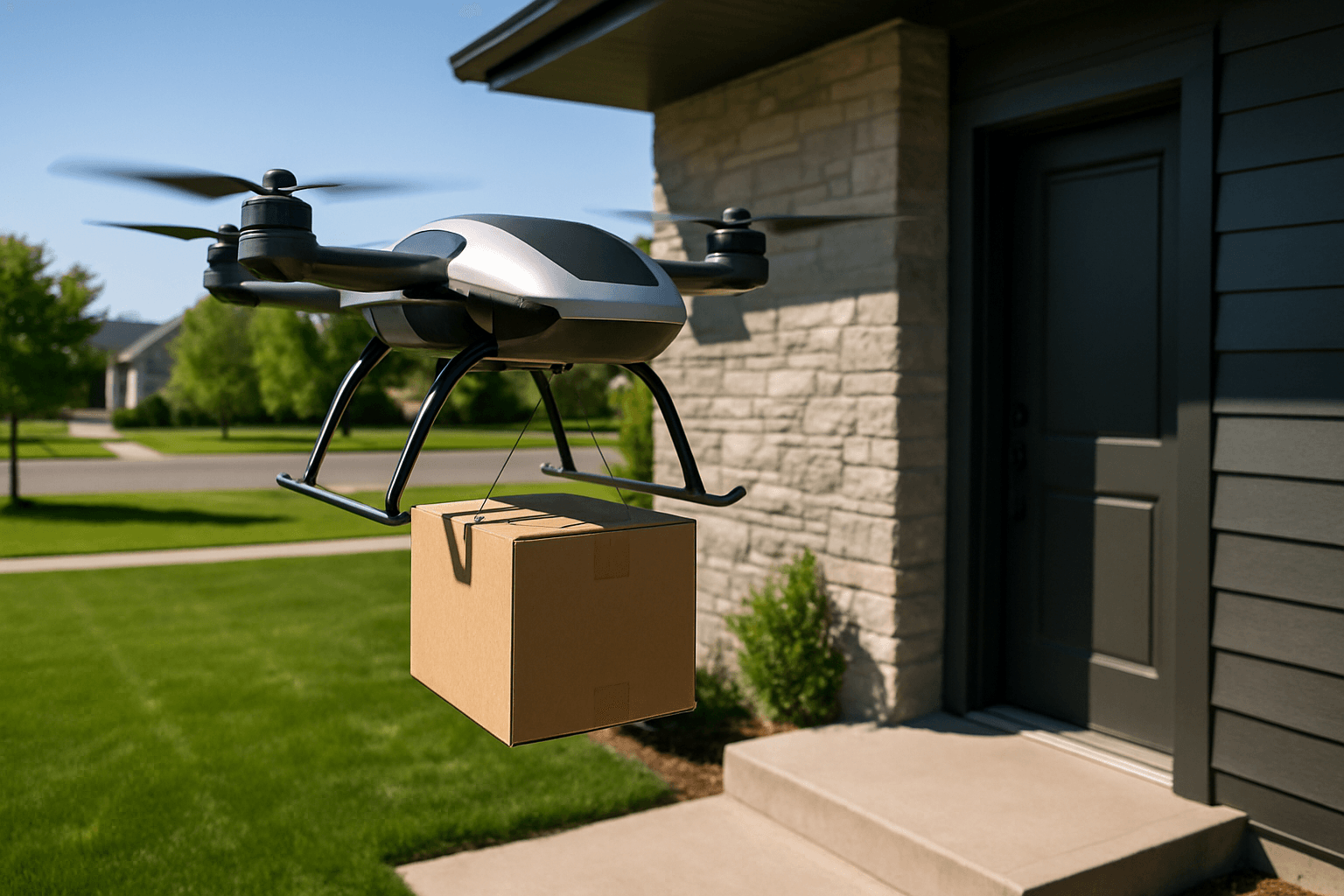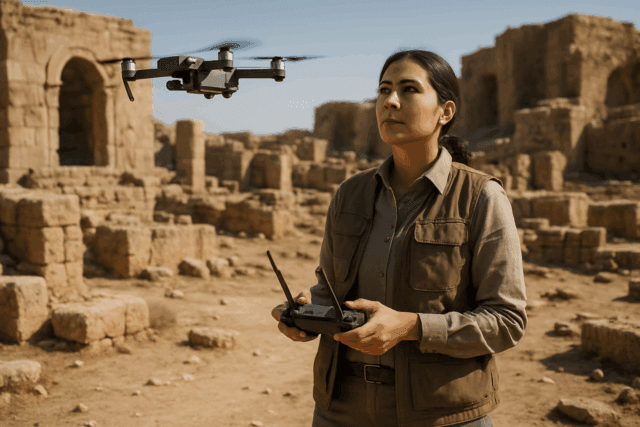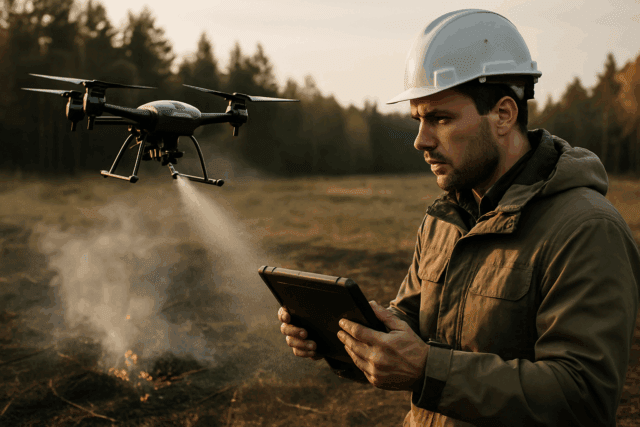The concept of drones delivering packages has moved from science fiction to a tangible reality, poised to revolutionize the UK logistics industry. With the promise of faster, more efficient, and environmentally friendly deliveries, major companies are investing heavily in drone technology and infrastructure. However, the path to widespread drone delivery faces regulatory hurdles, safety concerns, and public acceptance challenges.
The Current State of Drone Delivery in the UK
Drone delivery is gaining traction in the UK, with various trials and initiatives underway. Companies like Amazon, Royal Mail, and UPS have been experimenting with drone technology to enhance delivery speed and reach, particularly in remote areas.
- Amazon: Amazon is planning to launch a drone delivery service in the UK, with Darlington as the proposed first site. The company is seeking clearance from the Civil Aviation Authority (CAA) and lodging planning applications with the local authority to build flight operations facilities. Amazon aims to deliver packages to homes in less than an hour using its Prime Air fleet.
- Royal Mail: Royal Mail has been trialing drone technology to improve services to remote and island communities, including the Shetland Islands, the Orkney Islands, and the Isles of Scilly. In partnership with Skyports Drone Services, Royal Mail has established a daily inter-island mail distribution service in Orkney, shortening delivery times by up to 24 hours.
- NHS: The National Health Service (NHS) is exploring the use of drones for medical deliveries, particularly in hard-to-reach areas. New regulations planned for 2026 may allow drones to fly beyond visual line of sight (BVLOS), unlocking long-distance missions for NHS-related deliveries.
- Skyfarer: Skyfarer, a Coventry-based start-up, is focused on using drones for medical drone delivery. In partnership with Medical Logistics UK, Skyfarer is conducting BVLOS trials in a secured CAA-approved airspace called “The Medical Logistics UK Corridor”.
Benefits of Drone Delivery
Drone delivery offers a wide array of benefits compared to traditional delivery methods:
- Speed and Efficiency: Drones can fly directly to their destination, avoiding traffic congestion and obstacles on standard routes. This can significantly reduce delivery times, with some companies aiming for delivery within 30-60 minutes.
- Access to Remote Areas: Drones can access remote and rural areas that may lack the infrastructure required for traditional vehicles. They can navigate difficult terrains such as mountains, forests, and areas with poor road connectivity, making them ideal for delivering medical supplies, food, and other essentials to isolated communities.
- Reduced Emissions: Drones can help reduce transportation emissions and curb climate change. By reducing reliance on vehicles, drone delivery can contribute to meeting emissions targets set in global agreements.
- Lower Operating Costs: Drone delivery services have the potential to significantly reduce operating costs compared to vehicle delivery services. Analysts estimate that the operating costs for drone delivery can be 40% to 70% lower than traditional delivery methods.
- Contactless Delivery: Drones offer the convenience of contactless delivery with limited human intervention. This is particularly valuable in situations where minimizing human contact is important, such as during pandemics or for delivering sensitive medical supplies.
Challenges and Considerations
Despite the numerous benefits, drone delivery faces several challenges that need to be addressed before widespread adoption can occur:
- Regulatory Hurdles: Navigating the regulatory landscape is crucial for the future of drone delivery in the UK. Key challenges include airspace management, ensuring public safety, and aligning operations with CAA guidelines. Current regulations require drones to remain within the operator’s line of sight, limiting their operational range.
- Safety Concerns: Ensuring the safety of drone operations is paramount. This includes addressing potential risks such as drone malfunctions, collisions, and accidents. Robust safety measures, such as obstacle avoidance systems and remote monitoring, are essential to mitigate these risks.
- Public Acceptance: Gaining public acceptance is vital for the success of drone delivery. Concerns about privacy, noise pollution, and the potential for accidents need to be addressed to build public trust. Transparency, community engagement, and education are key to fostering public support.
- Weather Limitations: Weather conditions can significantly impact drone operations. Rain, wind, snow, and extreme temperatures can affect drone performance and safety. Developing drones that can operate in a wider range of weather conditions is crucial for ensuring reliable delivery services.
- Security Risks: Security risks, such as theft of packages and potential damage to drone equipment, need to be addressed. Measures such as secure landing locations, tamper-proof packaging, and anti-theft technology can help mitigate these risks.
- Limited Payload Capacity: Most drones have a limited payload capacity, restricting the size and weight of packages that can be delivered. This may limit the types of goods that can be transported by drone, particularly for deliveries involving larger or heavier items.
- Infrastructure Requirements: Establishing the necessary infrastructure for drone delivery, such as charging stations, maintenance facilities, and air traffic management systems, requires significant investment. Strategic planning and partnerships are essential to develop a robust and efficient drone delivery infrastructure.
The Future of Drone Delivery in the UK
The future of drone delivery in the UK looks promising, with ongoing advancements in technology, evolving regulations, and increasing public acceptance.
- Regulatory Changes: The UK government is investing in the CAA to build a regulatory framework for BVLOS drone operations. These changes could allow drones to fly longer distances and enable new applications, such as NHS deliveries to remote areas.
- Technological Advancements: Innovations in AI and robotics are fueling the drone delivery revolution. These technologies enhance navigation, safety, and efficiency, enabling drones to handle more complex deliveries seamlessly.
- Market Growth: Analysts project significant growth in the drone delivery market over the next decade. With improving unit economics and increasing adoption across various sectors, drone delivery is poised to become a mainstream delivery option.
- Expansion of Services: As the technology matures and regulations evolve, drone delivery services are expected to expand beyond last-mile delivery to include applications such as infrastructure inspection, emergency response, and environmental monitoring.
- Sustainability: Drone delivery offers a sustainable alternative to traditional delivery methods, reducing emissions and contributing to a greener future. As businesses and consumers become more environmentally conscious, the demand for eco-friendly delivery options like drones is likely to increase.
While challenges remain, the potential benefits of drone delivery are undeniable. As technology advances, regulations adapt, and public acceptance grows, drones are set to play an increasingly significant role in the UK’s logistics landscape, offering faster, more efficient, and sustainable delivery solutions.





